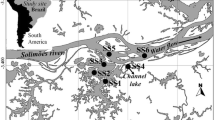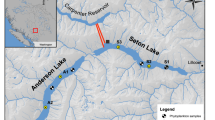Abstract
The Mary River, in the Australian wet/dry tropics, flows seasonally. When the river ceases flowing in the dry season, a series of isolated lakes remain along the river’s main floodplain channel. The limnology of a channel lake, which is 14 km long and 6-9 m deep in the dry season, was examined between April and December 2000. Four hydraulic phases were identified, these being (1) riverine (April), (2) riverine to lake transition (May), (3) lake (June–late-November), and (4) lake to riverine transition (late-November–December). These phases differ with respect to their duration and flow direction from lakes located on tropical floodplains of perennially flowing rivers. Despite the variable hydraulic conditions, the main channel remained thermally stratified, with only infrequent and short-lived deep mixing events, and sufficient light for photosynthesis in the diurnal mixed layer. During the period of isolation and in contrast to floodplain lakes in tropical South America, the depth of the Mary River channel lake always exceeded, by at least 2-fold, the depth of the diurnal mixed layer. The water quality (conductivity, dissolved oxygen, pH, Si and water clarity) and phytoplankton assemblage of the channel lake was primarily driven by its hydraulics, though this was not evident for the channel’s nutrient concentrations. Dissolved oxygen concentrations during lentic conditions were double values during the riverine and transition phases. This was attributed to the cessation of inflowing waters with a high biological oxygen demand, and enhanced photosynthetic activity of higher concentrations of phytoplankton retained under lentic conditions. The channel’s phytoplankton assemblage reflected the channel’s hydraulics, with the most common phytoplankton throughout the study period belonging to functional groups Lo(Peridinium inconspicuum), W1 (euglenoids), W2 (Trachelmonas) and Y (Cryptopmonas, Rhodomonas), with groups A (Acanthoceras) and D (Nitzschia agnita, Synedra alna) prominent during the lentic phase. Despite persistent stratification under lentic conditions, there was no clear evidence of autogenic succession or domination by any single phytoplankton functional group.
Similar content being viewed by others
References
InstitutionalAuthorNameAPHA (1998) Standard Methods for the Examination of Water and Wastewater. American Public Health Association, American Water Works Association and Water Environment Federation United Book Press Maryland
F. A. R. Barbosa J. Padisák (2002) ArticleTitleThe forgotten lake stratification pattern of atelomixis, and its ecological importance Verhandlungen der internationalen vereinigung für theroetische and angwandte limnologie 28 1385–1395 Occurrence Handle1:CAS:528:DC%2BD2MXhtVSksLbI
L. Belbin (1993) PATN – Pattern Analysis Package Commonwealth Scientific and Industrial Research Organization Canberra
D. E. Calheiros S. K. Hamilton (1998) ArticleTitleLimnological conditions associated with natural fish kills in the Pantanal wetland of Brazil Verhandlungen der internationalen vereinigung für theroetische and angwandte limnologie 26 2189–2193
I. D. Cuthbert P. Giorgio Particledel (1992) ArticleTitleToward a standard method of measuring colour in freshwater Limnology and Oceanography 37 1319–1326 Occurrence Handle1:CAS:528:DyaK3sXitF2gs7w%3D Occurrence Handle10.4319/lo.1992.37.6.1319
S. A. Day R. P. Wickham T. J. Entwistle P. A. Tyler (1995) Bibliographic Checklist of Non-Marine Algae in Australia Australian Biological Resources Study Canberra
M. D. Oliveira ParticleDe D. F. Calherios (2000) ArticleTitleFlood pulse influence on phytoplankton communities of the south Pantanal floodplain, Brazil Hydrobiologia 427 101–112
C. M. Finlayson B. J. Bailey W. J. Freeland M. R. Flemming (1988) Wetlands of the Northern Territory A. J. McComb P. S. Lake (Eds) Thc conservation of Australian wetlands Surrey Beatty and Sons Sydney 103–126
M. O. García Emiliani Particlede (1993) ArticleTitleSeasonal succession of phytoplankton in a lake of the Paraná River floodplain, Argentina Hydrobiologia 264 101–114
P. A. Gell J. A. Sonneman M. A. Reid M. A. Illman A. J. Sincock (1999) An Illustrated Key to Common Diatom Genera from Southern Australia Cooperative Research Centre for Freshwater Ecology Thurgoona (Australia)
S. K. Hamilton W. M. Lewis (1987) ArticleTitleCauses of seasonality in the chemistry of a lake on the Orinoco River floodplain, Venezuela Limnology and Oceanography 32 1277–1290 Occurrence Handle1:CAS:528:DyaL1cXotFGnsA%3D%3D Occurrence Handle10.4319/lo.1987.32.6.1277
S. K. Hamilton W. M. Lewis (1990) ArticleTitleBasin morphology in relation to chemical and ecological characteristics of lakes on the Orinoco River floodplain, Venezuela Archiv für Hydrobiologie 119 393–425 Occurrence Handle1:CAS:528:DyaK3MXitlCmsbY%3D
S. K. Hamilton S. J. Sippel J. M. Melack (2002) ArticleTitleComparison of inundation patterns among South American floodplains Journal of Geophysical Research 107 8038–8052
V. L. M. Huszar C. S. Reynolds (1997) ArticleTitlePhytoplankton periodicity and sequences of dominance in an Amazonian flood-plain lake (Lago Batata, Pará, Brazil): responses to gradual environmental change Hydrobiologia 346 169–181
V. L. M. Huszar L. H. S. Silva P. Domingos M. Marinho S. Melo (1997) ArticleTitlePhytoplankton species composition is more sensitive than OECD criteria to the trophic status of three Brazilian tropical lakes Hydrobiologia 369/370 59–71
M. Ibañez (1998) ArticleTitlePhytoplankton composition and abundance of a central Amazonian floodplain lake Hydrobiologia 362 79–83
S. B. Idso (1973) ArticleTitleOn the concept of lake stability Limnology and Oceanography 18 681–683 Occurrence Handle10.4319/lo.1973.18.4.0681
J. Imberger (1985) ArticleTitleThe diurnal mixed layer Limnology and Oceanography 30 737–770
Junk, W. J., P. B. Bayley & R. E. Sparks, 1989. The flood pulse concept in river-floodplain systems. In Dodge, D. P. (ed.), Proceedings of the International Large River Symposium. Special Publication of the Canadian Journal of Fisheries and Aquatic Sciences 106: 110–127.
J. T. O. Kirk (1983) Light and Photosynthesis in Aquatic Ecosystems Cambridge University Press Melbourne
L. F. Lesack J. M. Melack (1995) ArticleTitleFlooding hydrology and mixture dynamics of lake water derived from multiple sources in an Amazon floodplain lake Water Resources Research 31 329–345 Occurrence Handle10.1029/94WR02271
W. M. Lewis (2000) ArticleTitleBasis for the protection and management of tropical lakes Lakes & Reservoirs Research: and Management 5 34–48
H. U. Ling P. A. Tyler (1986) A Limnological Survey of the Alligator Rivers Region Part II: Freshwater Algae, Exclusive of Diatoms Australian Government Publishing Service Canberra
H. U. Ling P. A. Tyler (2000) Australian Freshwater Algae (Exclusive of Diatoms) Stuttgart J. Cramer
J. W. G. Lund C. Kipling E. D. Le Cren (1958) ArticleTitleThe inverted microscope method of estimating algal numbers and the statistical basis of estimations by counting Hydrobiologia 11 143–170 Occurrence Handle10.1007/BF00007865
S. MacIntyre J. M. Melack (1988) ArticleTitleFrequency and depth of vertical mixing in an Amazon floodplain lake (L. Calado, Brazil) Verhandlungen der internationalen vereinigung für theroetische and angwandte limnologie 23 80–85
J. M. Melack (1984) ArticleTitleAmazon floodplain lakes: shape, fetch and stratification Verhandlungen der internationalen vereinigung für theroetische and angwandte limnologie 22 1278–1282
J. M. Melack T. R. Fisher (1983) ArticleTitleDiel oxygen variations and their ecological implications in Amazon floodplain lakes Archiv für Hydrobiologie 98 422–442
InstitutionalAuthorNameOECD (1982) Eutrophication of Waters: Monitoring, Assessment and Control OECD Paris
K. Olrik (1994) Phytoplankton Ecology: Determining Factors for the Distribution of Phytoplankton in Freshwater and the Sea Danish Environmental Protection Agency Denmark
L. Powell S. A. Townsend (1997) A Survey of Water Quality in the Billabongs of the Mary River Floodplain: A Report for the Community Northern Territory Department of Lands, Planning and Environment Darwin
G. W. Prescott (1978) How to Know the Freshwater Algae W. C. Brown Company Duduque (USA)
C. S. Reynolds (1984) The Ecology of Freshwater Phytoplankton Cambridge University Press Cambridge
C. S. Reynolds (1988) ArticleTitleThe concept of ecological succession applied to seasonal periodicity of freshwater phytoplankton Verhandlungen der internationalen vereinigung für theroetische and angwandte limnologie 23 683–691
C. S. Reynolds (1997) Vegetation Processes in the Pelagic: A Model for Ecosystem Theory Ecology Institute Oldendorf
C. S. Reynolds V. Huszar C. Kruk L. Naselli-Flores S. Melo (2002) ArticleTitleTowards a functional classification of the freshwater phytoplankton Journal of Plankton Research 24 417–428 Occurrence Handle10.1093/plankt/24.5.417
S. J. Sippel S. K. Hamilton J. M. Melack (1992) ArticleTitleInundation area and morphometry of lakes on the Amazon River floodplain, Brazil Archiv für Hydrobiologie 123 385–400
U. Sommer (1989) The role of competition for resources in phytoplankton succession U. Sommer (Eds) Plankton Ecology: Succession in Plankton Communities SpringerVerlag Berlin 57–106
J. A. Sonneman A. Sincock J. Fluin M. Reid P. Newall J. Tiby P. Gell (1999) An Illustrated Guide to Common Stream Diatom Species from Temperate Australia Cooperative Research Centre for Freshwater Ecology Thurgoona (Australia)
J. F. Talling J. Lemoalle (1998) Ecological Dynamics of Tropical Inland Waters Cambridge University Press Cambridge
S. A. Townsend (1998) ArticleTitleThe influence of retention time and wind exposure on stratification and mixing in two tropical Australian reservoirs Archiv für Hydrobiologie 141 353–371
S. A. Townsend (1999) ArticleTitleThe seasonal pattern of dissolved oxygen, and hypolimnetic deoxygenation, in two tropical Australian reservoirs Lakes & Reservoirs: Research and Management 4 41–53
S. A. Townsend (2001) ArticleTitlePerennial domination of phytoplankton by Botryococcus and Peridinium in a discontinuously polymictic reservoir (tropical Australia) Archiv für Hydrobio-logie 151 529–548
S. A. Townsend C. A. Edwards (2003) ArticleTitleA fish kill event, hypoxia and other limnological impacts associated with early wet season flow into a lake on the Mary River floodplain, tropical northern Australia Lakes & Reservoirs: Research and Management 8 169–179
InstitutionalAuthorNameUSEPA (1974) An Approach to a Relative Trophic Index System for Classifying Lakes and Reservoirs U.S. Environmental Protection Agency Washington
E. Vásquez (1992) ArticleTitleTemperature and dissolved oxygen in lakes of the Lower Orinoco River floodplain (Venezuela) Revue d’hydrobiologie Tropicale 25 23–33
L. Vörös J. Padisák (1991) ArticleTitlePhytoplankton biomass and chlorophyll-a in some shallow lakes in central Europe Hydrobiologia 215 111–119
W. Vyvernam (1994) ArticleTitleLimnological features of lakes on the Sepik-Ramu floodplain, Papua New Guinea Australian Journal of Marine and Freshwater Research 45 1209–1224
E. J. Webber (2000) Response of Mary River Phytoplankton to Nitrogen and Phosphorus Enrichment Honors Thesis. Northern Territory University Darwin
Author information
Authors and Affiliations
Corresponding author
Rights and permissions
About this article
Cite this article
Townsend, S.A. Hydraulic Phases, Persistent Stratification, and Phytoplankton in a Tropical Floodplain Lake (Mary River, Northern Australia). Hydrobiologia 556, 163–179 (2006). https://doi.org/10.1007/s10750-005-0885-y
Received:
Revised:
Accepted:
Issue Date:
DOI: https://doi.org/10.1007/s10750-005-0885-y




